Measuring Heart Rate in Manual Wheelchair Users during Exercise and Free-living Activity with the latest Fitbit Surge Monitor
1-2KaLai Tsang, BS; 4Hui-Ju Yong, PhD; 4James Rimmer, PhD; 1-3Dan Ding, PhD
1Human Engineering Research Laboratories, Department of Veterans Affairs, Pittsburgh, PA 15206
2Department of Rehabilitation Science and Technology, University of Pittsburgh, Pittsburgh, PA 15260
3Department of Bioengineering, University of Pittsburgh, Pittsburgh, PA 15261
4School of Health Professions, University of Alabama at Birmingham, Birmingham, AL 35294
ABSTRACT
Researchers have been validating the off-the-shelf activity monitors and customizing devices to help manual wheelchair users (MWUs) objectively monitor their daily physical activity (PA), a critical factor in optimizing health and function. Some of these devices track heart rate (HR) and use it to predict energy expenditure (EE). The validity of these monitors in predicting EE depends on the accuracy of their HR measurement. In this study, we examined the validity of one of the most popular fitness-tracking devices, Fitbit Surge. Fifteen MWUs (spinal cord injury (n=9), spina bifida (n=2), cerebral palsy (n=1), multiple sclerosis (n=1), polymyositis (n=1), and traumatic brain injury (n=1), Age: 36.5 ± 9.9 years) wore the device during exercise and free-living activity. The Fitbit Surge HR measurement was compared against a reference HR measured by a validated device, ActiHeart (1, 2). Results showed the HR measured by Fitbit Surge and ActiHeart were strongly correlated (r= 0.64, p<0.001). The ICC (2, 1) was 0.78, indicating a moderate agreement. The mean bias between the HR measured by ActiHeart and Fitbit Surge was 1.9 bpm (95% limit of agreement: -35.8 – 39.6 bpm). However, the difference was substantially greater in higher intensity tasks (HR > 100 bpm) than in lower intensity tasks (HR < 100 bpm). The variance in HR of each subject recorded by ActiHeart and Fitbit Surge over the course of 2.5 hours were only comparable in sedentary tasks such as resting, watching TV and reading. More work needs to be done to better understand how to improve its sensitivity/specificity for capturing moderate to vigorous PA in MWUs across the day.
BACKGROUND
Heart rate (HR) is an important indicator of health and fitness. Evidence has shown that regular physical activity (PA), especially aerobic exercise, is associated with lower resting HR (3, 4). Other studies have also suggested that HR response during exercise and HR recovery after exercise could be used to predict risk of coronary heart disease and total mortality (5-7) . Besides, HR measurement can be used to predict energy expenditure (EE) in moderate to strenuous activities as the HR increases linearly with oxygen consumption (8).
In the past decades, increasing attention has been paid to the development and use of portable activity monitors to help manual wheelchair users (MWUs) adopt and maintain a healthier and more active lifestyle. Many of the popular off-the-shelf monitors such as ActiHeart and Fitbit Surge track HR and use it to predict EE. For example, Nightingale et al. (2015) found that ActiHeart showed a fair accuracy (absolute percent error: 16.8 ± 15.8%) in estimating EE in MWUs during PA (9). When investigating the abilities of monitors that use HR to estimate EE, their validity in measuring HR should first be examined.
Brage et al. (2005) and Barreira et al. (2009) had investigated the validity of ActiHeart in exercise and free-living activity in ambulatory population. Brage et al. (2005) showed that HR measured by ActiHeart were 0.1 bpm (95% limit of agreement: -4.2 – 4.3 bpm) and -0.4 bpm (95% limit of agreement: -3.4 – 2.6 bpm) different when compared to electrocardiogram (ECG) and Polar S610, respectively (1). The intraclass correlation coefficient (ICC) was 0.99 (p<0.001) between ActiHeart and ECG, indicating a strong agreement (1). Similarly, Barrier et al. (2009) reported a high correlation between HR measured by ActiHeart and ECG, with correlations ranged from 0.88 to 0.99 for low-, moderate-, high-intensity exercises, and free-living activities (2). ActiHeart was concluded to be a valid tool for HR measurement.
As one of the most popular fitness tracking devices nowadays, the validity of Fitbit Surge in measuring HR has not yet been determined. In this study, we investigated the performance of Fitbit Surge in tracking HR during exercise and free-living activity in MWUs by comparing it to the HR measurements collected using ActiHeart. We hypothesized that the HR measurements collected by the two devices would have small mean differences and high agreement.
METHOD
The study was approved by the Institutional Review Board at the University of Alabama at Birmingham. Fifteen subjects between the ages of 18 and 75 years were recruited in this study. Subjects were eligible to participate in the study if they 1) used manual wheelchairs as a primary means of mobility; 2) were at least one year post-injury; 3) were medically stable; 4) were able to tolerate sitting for 3 hours; and 5) had no active pelvic or thigh wounds. Subjects were excluded if pregnant or had cardiovascular diseases at the time of testing.
Instrumentation
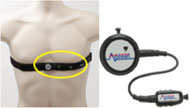

Procedure
The study was explained to the subjects, and written consent forms were obtained from them prior to participating in the study. Subjects were first asked to complete a basic demographic questionnaire and had their body weight and height measured.
There were two testing trials – lab and home. The lab trial took place at the Lakeshore Foundation, while the home trial took place at the Cottages of Lakeshore. All subjects began with resting for 30 min and 15 min for the lab and home trials, respectively.
During the lab trial, subjects were asked to perform at least six activities from the following list: wheelchair propulsion on a flat surface at self-selected slow, normal or fast speed; arm ergometry exercise at self-selected low, normal, or high speed/resistance; propulsion up/down a ramp, on a carpeted surface, on a sidewalk, or on a track at self-selected normal speed; wheelchair basketball; weight lifting; Theraband exercise. Subjects performed each activity of their choices for at least 10 minutes, and they were allowed to rest for at least 5 minutes between activities.
During the home trial, subjects were asked to perform 1.5 hours of free-living activities from the following list: reading; watching TV; cleaning house; folding clothes/bedsheets; washing dishes; stretching exercise; chair-aerobic exercise; resistance exercise. Instructional videos were provided for those who chose stretching, aerobic and/or resistance exercises. To mimic the real world situation, subjects were given enough time to finish each task they chose, and tasks were performed continuously without breaks.
Data Analysis
Data from ActiHeart was extracted using the ActiHeart software (version 4), with the HR data downloaded in 15s epoch. The Fitbit Surge data was achieved through Fitabase (Small Steps Labs LLC) with the HR data downloaded at 1s epoch. Both HR data were then condensed to 1-minute interval. The linear regression analysis and Pearson correlation coefficient were performed to examine the relationship between the HR measured by ActiHeart and Fitbit Surge. The ICC was calculated and the Bland-Altman plot was constructed to examine the agreement between the HR measured by the two devices. In addition, the variance in HR of each subject was computed by subtracting the HR between two time points. The data were split into two categories: sedentary and non-sedentary. In sedentary category, the variance in HR over time during resting, watching TV, and reading were included. The variance in HR during other activities were grouped into non-sedentary category. The mean and standard deviation of the variance in HR over time were calculated for each category.
RESULTS
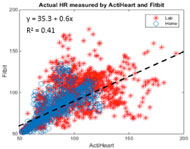
Since the nature of the physical activities performed in the lab trial was mainly exercise tasks while that in the home trial was free-living activities, we further examined the relationship between HR measured by both devices in the two trials separately. A stronger association was found between HR measured by ActiHeart and Fitbit Surge in the home trial (ICC (2, 1): 0.83 [95% confidence interval: 0.81 – 0.85]; r= 0.71) than in the lab trial (ICC (2, 1): 0.73 [95% confidence interval: 0.70 – 0.76]; r= 0.58).This result was also illustrated in Figure 3 and 4. The HR measured by the two devices showed greater differences during higher intensity tasks (HR above 100 bpm) than lower intensity tasks (HR below 100 bpm).
In addition, the variance in HR over the course of 2.5 hours measured by the two devices was calculated. The variance in HR of each subject performing the PA in sedentary and non-sedentary categories were plotted in Figure 5 and 6. The mean differences of variance in HR over time between the two devices were 2.4±7.8 bpm and 1.7±24.4 bpm in sedentary and non-sedentary categories, respectively.
Total Subjects |
15 |
|---|---|
Gender |
|
Male |
10 |
Female |
5 |
Age (years) |
36.5 ± 9.9 |
Height (inches) |
66.2 ± 6.0 |
Weight (lbs) |
155.0 ± 47.3 |
Years of using wheelchair |
15.2 ± 10.4 |
Disability type |
|
Spinal Cord Injury |
9 |
Spina Bifida |
2 |
Cerebral Palsy |
1 |
Multiple Sclerosis |
1 |
Polymyositis |
1 |
Traumatic Brain Injury |
1 |
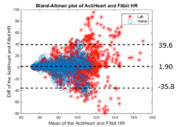
DISCUSSION
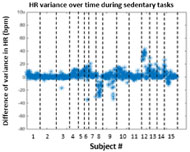
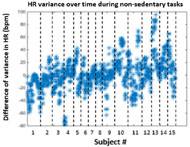
CONCLUSION
Overall, the HR measured by Fitbit Surge and ActiHeart showed a strong correlation and the mean bias was 1.9 bpm. However the mean differences of the HR measured by Fitbit Surge and ActiHeart were large in higher intensity tasks (HR > 100 bpm). The variance in HR over time recorded by the two devices only demonstrated good agreement in sedentary tasks. More work needs to be done to understand how to improve monitors like Fitbit Surge for capturing moderate to vigorous PA in MWUs across the day.
REFERENCES
10. CamNtech. ActiHeart Overview 2011 [updated December 20111/26/2016]. Available from: http://www.camntech.com/images/products/actiheart/Actiheart_4_Overview.pdf.
ACKNOWLEDGMENT
The work is supported by RecTech (Grant: H133E120005), the Lakeshore Foundation, the University of Alabama at Birmingham, and the University of Pittsburgh. The contents do not represent the views of the organization, or the universities.